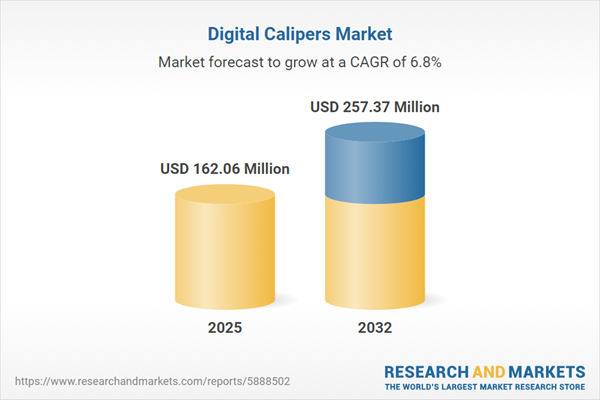Speak directly to the analyst to clarify any post sales queries you may have.
Digital calipers are increasingly foundational to advanced manufacturing operations, enabling organizations to strengthen quality assurance, automate compliance, and respond faster to dynamic production requirements. As digital measurement tools become more closely integrated with intelligent factory systems, senior leaders face critical opportunities to optimize operational outcomes and drive modernization initiatives across varied industrial settings.
Market Snapshot: Digital Calipers Market Trajectory
The digital calipers market is gaining sustained traction, currently valued at USD 151.78 million in 2024 and projected to reach USD 162.06 million by 2025. Over the coming years, the segment is expected to achieve a compound annual growth rate of 6.82%, expanding to USD 257.37 million by 2032. Key growth drivers include expanded adoption among manufacturers aiming to streamline production accuracy, minimize errors, and sharpen their competitive positioning. Integrating digital calipers with smart manufacturing infrastructure also supports the automation of compliance procedures and accelerates adaptation to evolving industry standards, making these instruments increasingly indispensable in modern industrial environments.
Scope & Segmentation of the Digital Calipers Market
Comprehensive segmentation equips decision-makers with actionable insights, supporting tailored strategies to meet diverse operational, regional, and compliance needs throughout the digital calipers space.
- Application Areas: Aerospace, automotive, electronics, and broad general manufacturing all utilize robust digital calipers engineered for reliable compliance management and precision in demanding measurement scenarios.
- Distribution Channels: Flexible sourcing is attainable through offline distributors, specialized retailers, manufacturer-direct purchasing, and online e-commerce channels, giving organizations agility to meet unique procurement demands.
- End Users: Solutions are tailored for DIY specialists, educational institutions, research organizations, and advanced production teams, with ergonomic designs and adaptable features supporting various workflows.
- Price Range Tiers: Options range from standard, affordable models to high-end digital calipers engineered for stringent compliance and accuracy requirements across regulated industries.
- Accuracy Classes: A spectrum of standard and high-precision devices equips businesses to select instruments that align with exacting regulatory expectations and project assurance objectives.
- Measurement Ranges: Offerings include devices suited to both minimal and extensive measurement needs, providing flexibility for application across small-scale, specialized, or large industrial projects.
- Geographical Regions: Major markets encompass the Americas, Europe, Middle East and Africa, and Asia-Pacific, each with distinct regulatory contexts and competitive sourcing frameworks that influence procurement decisions.
- Leading Companies: Innovation and accessibility are advanced through key players such as Mitutoyo Corporation, Hexagon AB, The L.S. Starrett Company, Mahr GmbH, TESA Technology SA, Fowler High Precision, INSIZE Co. Ltd., Sylvac SA, and Swiss Precision Instruments GmbH.
Key Takeaways for Senior Decision-Makers
- Digital calipers deliver robust traceability and facilitate real-time monitoring, supporting more effective quality control and compliance in intricate production workflows.
- Integration of wireless connectivity and cloud data management allows faster decision-making and streamlined process changes, supporting operational agility.
- Advanced materials and modular systems are engineered to maximize asset life, reduce downtime, and provide strong total cost of ownership benefits.
- Strategic solutions tailored to the electronics and highly regulated industries ensure built-in compliance that simplifies daily operations.
- Ongoing service contracts for calibration and analytical insights safeguard measurement accuracy throughout the lifecycle and deepen supplier partnerships.
- Multiplicity of sourcing approaches supports adaptive procurement as technology landscapes and industry standards evolve.
Tariff Impact and Global Supply Chain Evolution
In response to changing tariff structures, organizations are increasingly diversifying sourcing routes through Southeast Asia and Eastern Europe. This approach enables improved cost management, greater risk diversification, and flexibility through adaptive procurement models and enhanced vertical integration. These measures position companies to respond effectively to changing product demand and compliance obligations.
Methodology & Data Sources
This market assessment draws from executive interviews, structured industry surveys, and direct feedback from engineering and procurement experts. Supplementary technical literature, up-to-date regulatory resources, and patent analysis enhance the rigor of the recommendations and segment analysis.
Why This Report Matters
- Enables alignment of executive procurement and investment strategies with emerging digital caliper technologies and evolving market opportunities in key regions.
- Facilitates targeted modernization and operational improvement by clarifying core segments and highlighting areas for workflow advancement.
- Delivers evidence-based insights for decision-makers pursuing greater manufacturing efficiency and resilient, data-driven asset management.
Conclusion
Digital calipers play a pivotal role in enabling operational resilience, strategic procurement decisions, and ongoing process innovation across global manufacturing environments. Leveraging the insights from this market research, leaders can confidently support modernization and compliance initiatives.
Additional Product Information:
- Purchase of this report includes 1 year online access with quarterly updates.
- This report can be updated on request. Please contact our Customer Experience team using the Ask a Question widget on our website.
Table of Contents
3. Executive Summary
4. Market Overview
7. Cumulative Impact of Artificial Intelligence 2025
Companies Mentioned
The companies profiled in this Digital Calipers market report include:- Mitutoyo Corporation
- Hexagon AB
- The L.S. Starrett Company
- Mahr GmbH
- TESA Technology SA
- Fowler High Precision
- INSIZE Co., Ltd.
- Sylvac SA
- Swiss Precision Instruments GmbH
Table Information
| Report Attribute | Details |
|---|---|
| No. of Pages | 185 |
| Published | October 2025 |
| Forecast Period | 2025 - 2032 |
| Estimated Market Value ( USD | $ 162.06 Million |
| Forecasted Market Value ( USD | $ 257.37 Million |
| Compound Annual Growth Rate | 6.8% |
| Regions Covered | Global |
| No. of Companies Mentioned | 10 |









